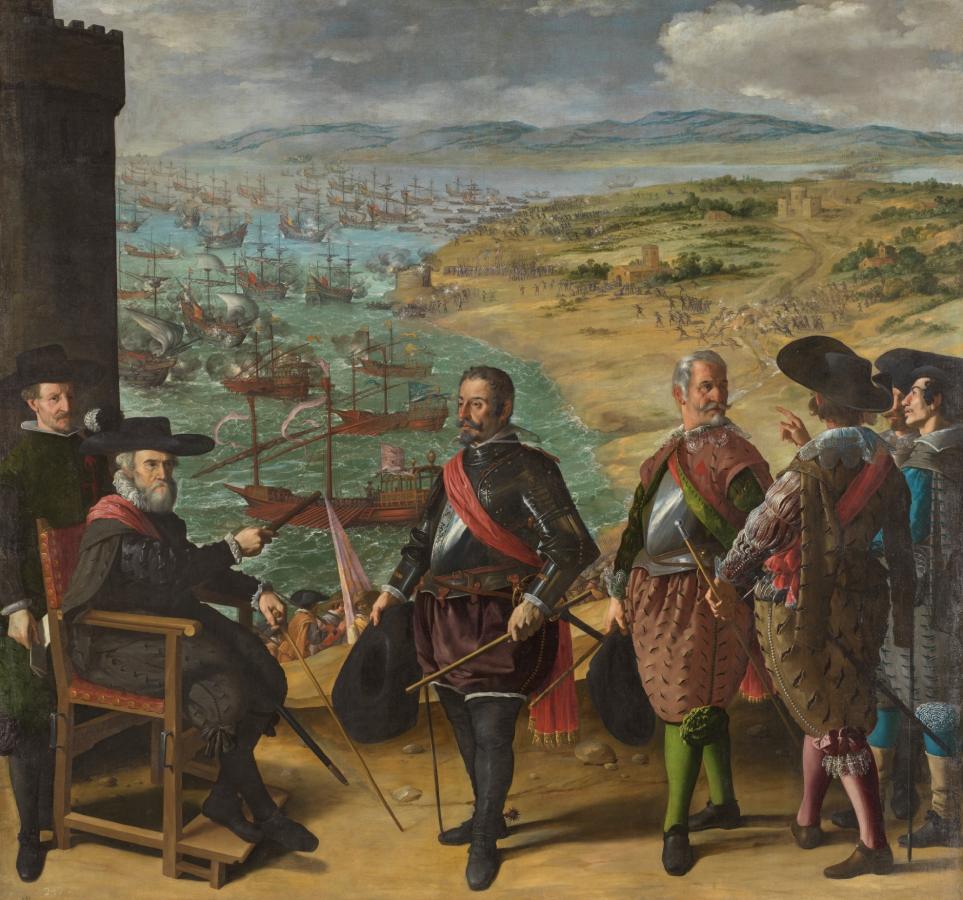Zurbarán, Francisco de (1598-1664)
Defensa de Cádiz contra los ingleses (Defence of Cadiz against the English)
1634–1635
Oil on canvas, 302 x 323 cm
Museo del Prado, Madrid
The event depicted is Cadiz’s defense from the attack of an English fleet of one hundred ships and ten thousand men commanded by sir Henry Cecil, Viscount of Wimbledon, which occurred on November 1, 1625. That defense was led by don Fernando Girón y Ponce de León, a veteran of the Flanders campaigns and a military advisor who had been appointed governor by the king after he offered his services in a speech before the Council of State on February 8, 1625. Gout-stricken and practically unable to move, he was forced to direct operations from an armchair, as can be seen in this painting. He was aided by the Duke of Fernandian, don García de Toledo y Osorio, who directed twelve galleys; the Marquis of Coprani, don Pedro Rodríguez de Santiesteban who, along with the Marquis of Torrecuso and Admiral Roque Centeno, commanded another fourteen ships that had recently arrived from the Indies; and the eighth Duke of Medina sidonia, don Manuel Pérez de Guzmán, who mobilized the militia in nearby villages to form a group of 6,000 men. The English entered the port of Cadiz on November 1 and obtained the surrender of the fort at El Puntal after a cannonade. They landed 10,000 men who overpowered la Almadraba de Hércules, but were stopped at Zuazo Bridge by troops under the Marquis of Coprani and the Corregidor of Jerez, Luis Portocarrero. Demoralized and harried by the Spanish forces, the English abandoned the battlefield on November 8, leaving behind 2000 men who had died in the battle or had drowned when hurriedly re-embarking via their skiffs, as chronicler Matías de Novoa put it. Like other battles commemorated in the Hall of Realms, this led to a play: La fe no ha menester armas y venida del ingles a Cádiz (Faith Needs no Weapons or The Arrival of the English in Cadiz), by Rodrigo de Herrera. Patricio Prieto Llovera has pointed out that the canvas perfectly depicts different parts of the land outside Cadiz and shows the naval skirmishes and fighting around the fort at El Puntal and la Almadraba de Hércules. In the foreground, above the walls in the area now known as Puerta de Tierra, Don Fernando Girón sits with a crutch in his left hand and a commander’s baton in his right. The person receiving Girón’s orders stands in the center and, as Ceán pointed out, he is undoubtedly don Diego Ruiz, his lieutenant colonel. The remaining figures have been tentatively identified in a variety of manners. The Knight of Saint James at Ruiz’s side, whose head is turned towards the three figures to the right is very likely don Lorenzo Cabrera y Orbera de la Maestra, Corregidor of Cadiz and master of its fortress, whose left arm had been injured in a previous battle. There are no reliable indications as to who the others are. The figure on the left, behind Girón, has sometimes been identified (by Ceán and others) as the Duke of Medina Sidonia, but Serrera has pointed out that, given his subordinate position and the fact that he bears a document, he may simply be an aide or perhaps Girón’s secretary. The letter of payment or receipt published by Caturla shows that Zurbarán charged 1,100 ducats for the ten paintings of the forces of Hercules and two large canvases that he has made of the Rescue of Cadiz […] for the Large Hall at the Buen Retiro. The listing of two canvases by Zurbarán related to the Rescue of Cadiz poses a problem we are not able to resolve today. The listing in the 1701 inventory of the painting that disappeared during the War of Independence (Another [painting] […] of the Marquis of Caderita with the Spanish Armada) does nothing to clarify the question and there is no information at all that would seem to refer to the second canvas by Zurbarán. (Museo Nacional del Prado, El Palacio del Rey Planeta, Museo Nacional del Prado, 2005, p.134-137)
